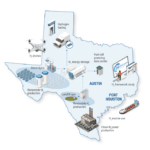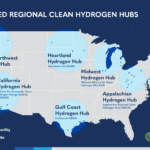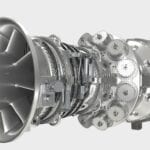Funding from the U.S. Department of Energy (DOE) will allow research organization GTI and its partners to proceed to the next phase of a project exploring how stored hydrogen can be used for load-following to improve the capacity factor of a natural gas combined cycle power plant.
The project is exploring a system that could demonstrate storage of more than 54 MWh of energy as clean hydrogen produced using natural gas with carbon capture and storage. The hydrogen would be used for load-following at Southern Co. Services’ 122-MW Washington County Cogeneration Facility in McIntosh, Alabama. “Hydrogen storage and discharge rates will be linked to follow daily power demand fluctuations from variable renewable energy to increase the plant’s efficiency and utilization while reducing emissions,” GTI said.
The DOE awarded GTI $800,000, allowing the research organization and project partners to proceed to Phase 2, which involves conducting a Preliminary Front End Engineering Design (pre-FEED) study of the system. Project partners include Southern Co., Pacific Gas & Electric, and the Electric Power Research Institute (EPRI). Cost share from the Low-Carbon Resources Initiative (LCRI), a joint program between GTI and EPRI that is supported by over 50 industry partners, will help fund the project, GTI said. The total project cost is estimated at $1.1 million.
Phase 1 of the project, which the DOE-funded, involved feasibility and techno-economic studies on “asset-integrated production and intermediate duration storage of hydrogen.” Studies suggested high-efficiency production using GTI’s hydrogen generator technology would achieve carbon capture rate of greater than 95% at a low-cost in a natural gas combined-cycle plant.
GTI noted it is currently piloting its hydrogen generation technology under a DOE-sponsored 300-kW project at the organization’s Des Plaines, Illinois, campus. Work is separately continuing at a larger 1.6-MW Hydrogen by Sorbent Enhanced Steam Reforming (HyPER) project with Cranfield University and Doosan Babcock. The UK Department for Business, Energy, and Industrial Strategy (BEIS) is sponsoring that project. “Both of these pilot projects are nearing commissioning and operation,” GTI said.
The technology essentially leverages a hydrogen production process with an inherent capability for carbon dioxide (CO2) separation. “The process is a cost-competitive, steam-neutral alternative to traditional steam methane reforming (SMR),” GTI explained. “It also produces a higher-quality hydrogen stream (of more than 90%, which can be upgraded further) while eliminating the need for a water gas shift reactor. Furthermore, it inherently captures the CO2 in solid phase,” it said. “This eliminates the associated capital expenditure and operating expenses of amine-based systems required for CO2 capture from SMR and natural gas combined cycle–based power systems.”
Previous tests have verified catalyst stability and successfully demonstrated sorption enhanced reforming (SER) chemistry and process operation. “Hydrogen purity and yield were at or above expected levels for the limited sorbent feed rates,” GTI said. Steps are also underway to upgrade the pilot using an indirectly fired calciner, and demonstrate operations.
“This new DOE project builds on GTI’s decades of expertise in hydrogen—along with integrated hydrogen testing, modeling, and demonstration facilities—to shape hydrogen markets and ensure this low-carbon fuel is affordable and accessible to economies of all sizes and maturities,” said Don Stevenson, GTI vice president, Energy Supply and Conversion.
The funding is part of $2.4 million that the DOE designated on March 21 to three projects that it suggested could advance novel thermal and hydrogen energy storage technologies, with an emphasis on increased duration, reliability, and affordability. “The technologies will initially support transitioning of existing fossil assets to low carbon energy systems, with the long-term potential to support the Biden-Harris Administration’s goal of a fully decarbonized electricity grid by 2035,” the DOE said.
The projects, which will be overseen by the DOE’s National Energy Technology Laboratory (NETL) also include awards for $800,000 to EPRI and partners to perform a pre-FEED study on the integration of a 10-MWh(e) SandTES pilot system into Alabama Power’s Ernest C. Gaston Electric Generating Plant in Wilsonville, Alabama. “SandTES is a high-temperature thermal energy storage technology operated with sand (quartz or silica) as the storage medium,” EPRI said. “The use of sand as a heat transfer material offers the advantages of widespread availability, low cost, and high thermal capacity.”
The final $800,000 award will go to WE New Energy Inc. and partners to complete a pre-FEED study of a “cost-effective” steel-concrete composite hydrogen energy storage prototype that is integrated with existing or new coal- and gas-fueled electricity generating units. “These units usually are not designed to respond to major shifts in output. This integrated system will enable more flexible operations, helping to manage dynamic changes in electric grid demand and electricity price,” the DOE said.
—Sonal Patel is a POWER senior associate editor (@sonalcpatel, @POWERmagazine).










